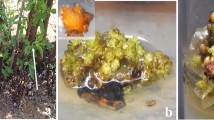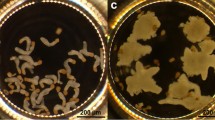Abstract
Striga is a genus of parasitic plants that poses great danger to livelihoods of millions of smallholder farmers in sub-Saharan Africa by limiting production of staple cereals. The parasite attaches to the roots of the crop and establishes a vascular connection with the host’s xylem vessels in order to access water, organic and inorganic nutrients, leading to stunted growth and death of the infected plant. Mechanisms underpinning host–parasite interactions are not clearly understood making well-informed strategies for control of the parasite difficult. To facilitate studies of Striga–host interactions for molecular and genetic studies, we: (i) established an efficient protocol for growing Striga from seeds in tissue culture; (ii) optimized protocols for its regeneration through direct organogenesis and somatic embryogenesis, and (iii) determined the effect of co-culturing host and parasite in the same culture media. We found the best auxin and cytokinin concentrations to be: 10.7 μM naphthaleneacetic acid (NAA) and 2.2 μM 6-benzylaminopurine (BAP) for embryogenic callus regeneration and 1.1–4.4 μM BAP without NAA for shoot multiplication. While seedling, stem and leaf explants induced callus with the same frequency, seed radicles did not produce any callus. Unexpectedly, we found that when Striga callus was added in rice growing on culture media, the parasite adversely affected the host through formation of lesions on leaves and resulted in less shoot induction from callus in the parasite. Techniques described in this study will enhance further understanding of Striga–host interactions.
Key message
Highly efficient protocols for tissue culture of the obligate parasitic plant Striga hermonthica and detection of host phytotoxicity by the parasite on culture media.






Similar content being viewed by others
References
Aly R, Hamamouch N, Abu-Nassar J, Wolf S, Joel DM, Eizenberg H, Westwood JH (2011) Movement of protein and macromolecules between host plants and the parasitic weed Phelipanche aegyptiaca Pers. Plant Cell Rep 30:2233–2241. https://doi.org/10.1007/s00299-011-1128-5
Berner DK, Winslow MD (1997) Striga research methods: a manual. IITA, Ibadan
Cai T, Babiker AG, Ejeta G, Butler LG (1993) Morphological response of witchweed (Striga asiatica) to in vitro culture. J Exp Bot 44:1377–1384. https://doi.org/10.1093/jxb/44.8.1377
Cissoko M, Boisnard A, Rodenburg J, Press MC, Scholes JD (2011) New Rice for Africa (NERICA) cultivars exhibit different levels of post-attachment resistance against the parasitic weeds Striga hermonthica and S. asiatica. New Phytol 192:952–963. https://doi.org/10.1111/j.1469-8137.2011.03846.x
De Groote H, Wangare L, Kanampiu F, Odendo M, Diallo D, Karaya H, Friesen D (2008) The potential of a herbicide resistant maize technology for Striga control in Africa. Agr Syst 97:83–94. https://doi.org/10.1016/j.agsy.2007.12.003
Delavault P, Montiel G, Brun G, Pouvreau JB, Thoiron S, Simier P (2017) Communication between host plants and parasitic plants. In: Becard G (ed) How plants communicate with their biotic environment. Elsevier, Amsterdam, pp 55–82
Ejeta G (2007) Breeding for resistance in sorghum: exploitation of an intricate host–parasite biology. Crop Sci 47:S–216–S–227. https://doi.org/10.2135/cropsci2007.04.0011ipbs
Fernández-Aparicio M, Rubiales D, Bandaranayake PC, Yoder JI, Westwood JH (2011) Transformation and regeneration of the holoparasitic plant Phelipanche aegyptiaca. Plant Methods 7:36. https://doi.org/10.1186/1746-4811-7-36
George EF (1993) Plant propagation by tissue culture: In practice. Part 1: The technology 2nd edn. Exegetics, Edington
Hearne SJ (2009) Control - the Striga conundrum. Pest Manag Sci 65:603–614. https://doi.org/10.1002/ps.1735
Ichihashi Y, Mutuku JM, Yoshida S, Shirasu K (2015) Transcriptomics exposes the uniqueness of parasitic plants. Brief Funct Genom 14:275–282. https://doi.org/10.1093/bfgp/elv001
Ishida JK, Yoshida S, Ito M, Namba S, Shirasu K (2011) Agrobacterium rhizogenes-mediated transformation of the parasitic plant Phtheirospermum japonicum. PLoS ONE 6(10):e25802. https://doi.org/10.1371/journal.pone.0025802
Kanampiu F, Makumbi D, Mageto E, Omanya G, Waruingi S, Musyoka P, Ransom J (2018) Assessment of management options on Striga infestation and maize grain yield in Kenya. Weed Sci 66:516–524. https://doi.org/10.1017/wsc.2018.4
Libiaková D, Ruyter-Spira C, Bouwmeester HJ, Matusova R (2018) Agrobacterium rhizogenes transformed calli of the holoparasitic plant Phelipanche ramosa maintain parasitic competence. Plant Cell Tiss Organ Cult 135:321. https://doi.org/10.1007/s11240-018-1466-x
Mok DW, Mok MC (2001) Cytokinin metabolism and action. Annu Rev Plant Physiol Plant Mol Biol 52(1):89–118. https://doi.org/10.1146/annurev.arplant.52.1.89
Musselman LJ (1980) The biology of Striga, Orobanche, and other root-parasitic weeds. Ann Rev Phytopathol 18:463–469. https://doi.org/10.1146/annurev.py.18.090180.002335
Okonkwo SN (1966) Studies on Striga senegalensis III. In vitro culture of seedlings. establishment of cultures. Am J Bot 53:679–687. https://doi.org/10.1002/j.1537-2197.1966.tb14023.x
Ranjan A, Ichihashi Y, Farhi M, Zumstein K, Townsley B, David-Schwartz R, Sinha NR (2014) De novo assembly and characterization of the transcriptome of the parasitic weed dodder identifies genes associated with plant parasitism. Plant Physiol 166:1186–1199. https://doi.org/10.1104/pp.113.234864
Rank C, Rasmussen LS, Jensen SR, Pierce S, Press MC, Scholes JD (2004) Cytotoxic constituents of Alectra and Striga species. Weed Res 44:265–270. https://doi.org/10.1111/j.1365-3180.2004.00398.x
Rodenburg J, Demont M, Zwart SJ, Bastiaans L (2016) Parasitic weed incidence and related economic losses in rice in Africa. Agric Ecosyst Environ 235:306–317. https://doi.org/10.1016/j.agee.2016.10.020
Rodenburg J, Cissoko M, Kayongo N, Dieng I, Bisikwa J, Irakiza I, Masoka I, Midega CAO, Scholes JD (2017) Genetic variation and host-parasite specificity of Striga resistance and tolerance in rice: the need for predictive breeding. New Phytol 214:1267–1280. https://doi.org/10.1111/nph.14451
Skoog F, Miller CO (1957) Chemical regulation of growth and organ formation in plant tissues cultured in vitro. Symp Soc Exp Biol 54:118–130
Sun G, Xu Y, Liu H, Sun T, Zhang J, Hettenhausen C, Shen G, Qi J, Qin Y, Li J, Wang L, Chang W, Guo Z, Baldwin IT, Wu J (2018) Large-scale gene losses underlie the genome evolution of parasitic plant Cuscuta australis. Nat Commun 9:2683. https://doi.org/10.1038/s41467-018-04721-8
Tomilov A, Tomilova N, Yoder JI (2007) Agrobacterium tumefaciens and Agrobacterium rhizogenes transformed roots of the parasitic plant Triphysaria versicolor retain parasitic competence. Planta 225(5):1059–1071. https://doi.org/10.1007/s00425-006-0415-9
Vogel A, Schwacke R, Denton A, Usadel B, Hollmann J, Fischer K, Bolger A, Schmidt MHW, Bolger ME, Gundlach H, Mayer KFX, Weiss-Schneeweiss H, Temsch EM, Krause K (2018) Footprints of parasitism in the genome of the parasitic flowering plant Cuscuta campestris. Nat Commun 9:2515. https://doi.org/10.1038/s41467-018-04344-z
Westwood JH, dePamphilis CW, Das M, Fernández-Aparicio M, Honaas LA et al (2011) The Parasitic Plant Genome Project: new tools for understanding the biology of Orobanche and Striga. Weed Sci 60:295–306. https://doi.org/10.2307/41497638
Wolf SJ, Timko MP (1991) In vitro root culture: a novel approach to study the obligate parasite Striga asiatica (L.) Kuntze. Plant Sci 73:233–242. https://doi.org/10.1016/0168-9452(91)90033-5
Worsham AD, Moreland DE, Klingman GC (1959) Stimulation of Striga asiatica (Witchweed) seed germination by 6-Substituted purines. Science 130:1654–1656. https://doi.org/10.1126/science.130.3389.1654
Yang Z, Wafula EK, Honaas LA, Zhang H, Das M, Fernandez-aparicio M et al (2015) Comparative transcriptome analyses reveal core parasitism genes and suggest gene duplication and repurposing as sources of structural novelty. Mol Biol Evol 32:767–790. https://doi.org/10.1093/molbev/msu343
Yoshida S, Cui S, Ichihashi Y, Shirasu K (2016) The Haustorium, a specialized invasive organ in parasitic plants. Annu Rev Plant Biol 67(1):643–667. https://doi.org/10.1146/annurev-arplant-043015-111702
Zhou WJ, Yoneyama K, Takeuchi Y, Iso S, Rungmekarat S, Chae SH et al (2004) In vitro infection of host roots by differentiated calli of the parasitic plant Orobanche. J Exp Bot 55:899–907. https://doi.org/10.1093/jxb/erh098
Acknowledegments
This research project was supported by the Biotechnology and Biological Sciences Research Council (BBSRC) and the Department for International (DfID) contract number BB/J011703/1 under the Sustainable Crop Production Research for International Development (SCPRID) Research Initiative. Additional support was provided by the International Centre for Genetic Engineering and Biotechnology (ICGEB) under the Collaborative Research Projects (CRP) initiative, contract number CRP/KEN17-03.
Author information
Authors and Affiliations
Contributions
SR and JDS conceived and designed the experiments on optimization of in vitro culture conditions for S. hermonthica. JDS further conceived the experiment on host-parasite interactions on in vitro media. DNW, EK, and JB performed experiments guided by SR and JDS. All authors wrote, read and approved the final manuscript.
Corresponding authors
Ethics declarations
Conflict of interest
The authors declare that they have no conflict of interest.
Additional information
Communicated by Ali R. Alan.
Publisher's Note
Springer Nature remains neutral with regard to jurisdictional claims in published maps and institutional affiliations.
Rights and permissions
About this article
Cite this article
Waweru, D.N., Kuria, E.K., Bradley, J.M. et al. Tissue culture protocols for the obligate parasitic plant Striga hermonthica and implications for host-parasite co-cultivation. Plant Cell Tiss Organ Cult 138, 247–256 (2019). https://doi.org/10.1007/s11240-019-01621-7
Received:
Accepted:
Published:
Issue Date:
DOI: https://doi.org/10.1007/s11240-019-01621-7




